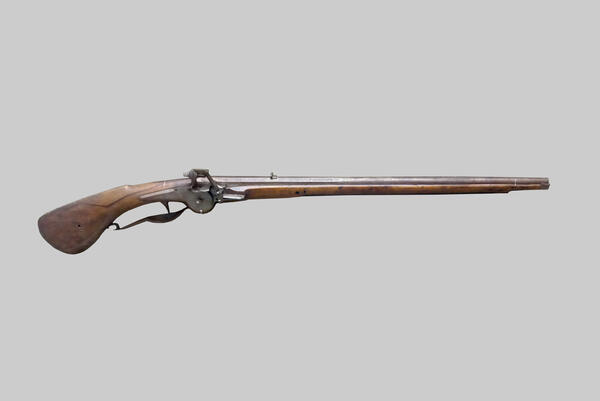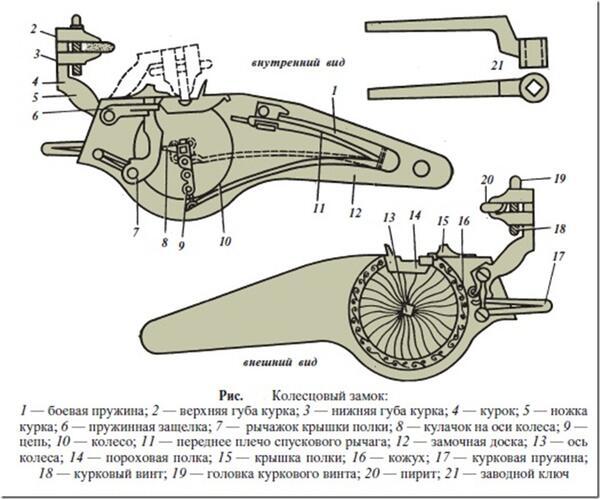The wheellock design was first introduced in the Codex AtlAnticus by Leonardo da Vinci in 1478–1519. The sketches of the lock themselves are dated to 1480-1485, when the artist made some works for Gentile dei Borri, the ducal armorer at the court of Ludovico Sforza.
Wheellock rifle
Время создания
first half of the 18th century–19th century
Место создания
Western Europe
Размер
104х11 cm
Техника
iron, wood
Коллекция
Выставка
0
Открыть в приложении#6
Wheellock rifle
#7
#4
Wheellock scheme
#8
The wheellock operated like a large cigarette lighter. A rotating wheel with notches pressed against a piece of pyrite, a mineral also known as fool’s gold. The result was a cascade of sparks that ignited the powder.
The wheel, which was turned using a short chain, was mounted on a spindle - a special shaft. The mechanism was wound with a key, like a watch. This way, the spring was compressed, and the chain was wound on the spindle. The fully wound device was locked by a system of levers. Pulling the trigger released the lever, and the wheel would begin to rotate rapidly.
A piece of pyrite was fixed in a clamp at the end of the trigger; the trigger was moved toward the wheel manually. The flashpan was closed with a sliding lid with a small handle. In later wheellocks, the flashpan lid moved automatically when the trigger was pulled.
Weapons with a wheellock and a short barrel were fired from the cheek, the heavy barrel took on most of the recoil from the rather weak gunpowder, which was used in weapons by the wealthiest people of the 16th century. Ordinary hunters would make do with the simple and rather unreliable matchlock, which often gave itself away by emitting smoke.
Most rifles could be loaded with one or more bullets, as the shooter wished. In 1524, Benvenuto Cellini wrote of “a straight rifle for hunting birds, which he made himself and finished so carefully inside and outside that it had no equals”. Unlike other contemporary devices, Cellini carefully loaded his rifle with a single round bullet and shot at game and peacocks. He boasted that by applying a charge equal to a fifth of a ball he could accurately hit the target at a distance of two hundred steps.
The wheellock turned out to be a successful invention. Reliability and low dependence on the weather determined its long life. However, it was very expensive and difficult to manufacture and maintain. As a result, when, during the Thirty Years' War, the issue of mass armament of armies became acute, the old matchlock became the main mechanism. The wheellock was used for pistols as the only one suitable for them, as well as for expensive weapons, sporting or hunting rifles.
After mass production of the battery modification of the flintlock began, it became preferred for all types of weapons and replaced the matchlock. Nevertheless, hunting weapons with a wheellock were produced in Munich workshops until the middle of the 18th century.
The wheel, which was turned using a short chain, was mounted on a spindle - a special shaft. The mechanism was wound with a key, like a watch. This way, the spring was compressed, and the chain was wound on the spindle. The fully wound device was locked by a system of levers. Pulling the trigger released the lever, and the wheel would begin to rotate rapidly.
A piece of pyrite was fixed in a clamp at the end of the trigger; the trigger was moved toward the wheel manually. The flashpan was closed with a sliding lid with a small handle. In later wheellocks, the flashpan lid moved automatically when the trigger was pulled.
Weapons with a wheellock and a short barrel were fired from the cheek, the heavy barrel took on most of the recoil from the rather weak gunpowder, which was used in weapons by the wealthiest people of the 16th century. Ordinary hunters would make do with the simple and rather unreliable matchlock, which often gave itself away by emitting smoke.
Most rifles could be loaded with one or more bullets, as the shooter wished. In 1524, Benvenuto Cellini wrote of “a straight rifle for hunting birds, which he made himself and finished so carefully inside and outside that it had no equals”. Unlike other contemporary devices, Cellini carefully loaded his rifle with a single round bullet and shot at game and peacocks. He boasted that by applying a charge equal to a fifth of a ball he could accurately hit the target at a distance of two hundred steps.
The wheellock turned out to be a successful invention. Reliability and low dependence on the weather determined its long life. However, it was very expensive and difficult to manufacture and maintain. As a result, when, during the Thirty Years' War, the issue of mass armament of armies became acute, the old matchlock became the main mechanism. The wheellock was used for pistols as the only one suitable for them, as well as for expensive weapons, sporting or hunting rifles.
After mass production of the battery modification of the flintlock began, it became preferred for all types of weapons and replaced the matchlock. Nevertheless, hunting weapons with a wheellock were produced in Munich workshops until the middle of the 18th century.
#9
State Budget Cultural Institution Pskov-Izborsk United Museum Preserve
читать дальшескрыть
00:00
00:00
1x
Wheellock rifle
Время создания
first half of the 18th century–19th century
Место создания
Western Europe
Размер
104х11 cm
Техника
iron, wood
Коллекция
Выставка
0
Открыть в приложении
Поделиться




